Investigating the Performance of Carbon Monoxide and Methane Observations from Sentinel-5 Precursor in China
Abstract
:1. Introduction
2. Materials and Methods
2.1. S5P Carbon Monoxide and Methane Dataset
2.2. Ground-Based FTIR Dataset
2.3. Validation Methodology
3. Results
3.1. Validation with TCCON Measurements
3.2. The Coincident Radius Dependence Relative to TCCON
3.3. Distributions and Trends of Annual Means around Sites
4. Discussion and Conclusions
Author Contributions
Funding
Data Availability Statement
Acknowledgments
Conflicts of Interest
References
- Veefkind, J.; Aben, I.; McMullan, K.; Förster, H.; de Vries, J.; Otter, G.; Claas, J.; Eskes, H.; de Haan, J.; Kleipool, Q.; et al. TROPOMI on the ESA Sentinel-5 Precursor: A GMES mission for global observations of the atmospheric composition for climate, air quality and ozone layer applications. Remote Sens. Environ. 2012, 120, 70–83. [Google Scholar] [CrossRef]
- Tian, Y.; Sun, Y.; Borsdorff, T.; Liu, C.; Liu, T.; Zhu, Y.; Yin, H.; Landgraf, J. Quantifying CO emission rates of industrial point sources from Tropospheric Monitoring Instrument observations. Environ. Res. Lett. 2022, 17, 014057. [Google Scholar] [CrossRef]
- Tian, Y.; Liu, C.; Sun, Y.; Borsdorff, T.; Landgraf, J.; Lu, X.; Palm, M.; Notholt, J. Satellite observations reveal a large CO emission discrepancy from industrial point sources over China. Geophys. Res. Lett. 2022, 49, e2021GL097312. [Google Scholar] [CrossRef]
- Pandey, S.; Gautam, R.; Houweling, S.; van der Gon, H.D.; Sadavarte, P.; Borsdorff, T.; Hasekamp, O.; Landgraf, J.; Tol, P.; van Kempen, T.; et al. Satellite observations reveal extreme methane leakage from a natural gas well blowout. Proc. Natl. Acad. Sci. USA 2019, 116, 26376–26381. [Google Scholar] [CrossRef] [PubMed]
- Borsdorff, T.; de Brugh, J.A.; Pandey, S.; Hasekamp, O.; Aben, I.; Houweling, S.; Landgraf, J. Carbon monoxide air pollution on sub-city scales and along arterial roads detected by the Tropospheric Monitoring Instrument. Atmos. Chem. Phys. 2019, 19, 3579–3588. [Google Scholar] [CrossRef] [Green Version]
- Borsdorff, T.; Reynoso, A.G.; Maldonado, G.; Mar-Morales, B.; Stremme, W.; Grutter, M.; Landgraf, J. Monitoring CO emissions of the metropolis Mexico City using TROPOMI CO observations. Atmos. Chem. Phys. 2020, 20, 15761–15774. [Google Scholar] [CrossRef]
- Connors, V.S.; Gormsen, B.B.; Nolf, S.; Reichle, H.G., Jr. Spaceborne observations of the global distribution of carbon monoxide in the middle troposphere during april and october 1994. J. Geophys. Res. Atmos. 1999, 104, 21455–21470. [Google Scholar] [CrossRef]
- Dekker, I.N.; Houweling, S.; Pandey, S.; Krol, M.; Röckmann, T.; Borsdorff, T.; Landgraf, J.; Aben, I. What caused the extreme CO concentrations during the 2017 high-pollution episode in India? Atmos. Chem. Phys. 2019, 19, 3433–3445. [Google Scholar] [CrossRef] [Green Version]
- Spivakovsky, C.M.; Logan, J.A.; Montzka, S.; Balkanski, Y.; Foreman-Fowler, M.; Jones, D.B.A.; Horowitz, L.; Fusco, A.C.; Brenninkmeijer, C.A.M.; Prather, M.J.; et al. Three-dimensional climatological distribution of tropospheric OH: Update and evaluation. J. Geophys. Res. Atmos. 2000, 105, 8931–8980. [Google Scholar] [CrossRef]
- Holloway, T.; Levy, H.; Kasibhatla, P. Global distribution of carbon monoxide, Journal of Geophysical Research. Atmospheres 2000, 105, 12123–12147. [Google Scholar] [CrossRef]
- Stocker, T.F.; Qin, D.; Plattner, G.-K.; Tignor, M.; Allen, S.K.; Boschung, J.; Nauels, A.; Xia, Y.; Bex, V.; Midgley, P.M. International Panel on Climate Change (2013). In Climate Change 2013: The Physical Science Basis. Contribution of Working Group I to the Fifth Assessment Report of the Intergovernmental Panel on Climate Change; IPCC: New York, NY, USA; Cambridge University Press: Cambridge, UK, 2013. [Google Scholar]
- Alvarez, R.A.; Zavala-Araiza, D.; Lyon, D.R.; Allen, D.T.; Barkley, Z.R.; Brandt, A.R.; Davis, K.J.; Herndon, S.C.; Jacob, D.J.; Karion, A.; et al. Assessment of methane emissions from the U.S. oil and gas supply chain. Science 2018, 361, 186–188. [Google Scholar] [CrossRef] [PubMed]
- Saunois, M.; Bousquet, P.; Poulter, B.; Peregon, A.; Ciais, P.; Canadell, J.G.; Dlugokencky, E.J.; Etiope, G.; Bastviken, D.; Houweling, S.; et al. The global methane budget 2000–2012. Earth Syst. Sci. Data 2016, 8, 697–751. [Google Scholar] [CrossRef] [Green Version]
- International Energy Agency. World Energy Outlook 2017; OECD Publishing: Paris, France, 2017. [Google Scholar]
- Sha, M.K.; Langerock, B.; Blavier, J.-F.L.; Blumenstock, T.; Borsdorff, T.; Buschmann, M.; Dehn, A.; De Mazière, M.; Deutscher, N.M.; Feist, D.G.; et al. Validation of methane and carbon monoxide from Sentinel-5 Precursor using TCCON and NDACC-IRWG stations. Atmos. Meas. Tech. 2021, 14, 6249–6304. [Google Scholar] [CrossRef]
- Borsdorff, T.; de Brugh, J.A.; Hu, H.; Hasekamp, O.; Sussmann, R.; Rettinger, M.; Hase, F.; Gross, J.; Schneider, M.; Garcia, O.; et al. Mapping carbon monoxide pollution from space down to city scales with daily global coverage. Atmos. Meas. Tech. 2018, 11, 5507–5518. [Google Scholar] [CrossRef] [Green Version]
- Liu, D.; Di, B.; Luo, Y.; Deng, X.; Zhang, H.; Yang, F.; Grieneisen, M.L.; Zhan, Y. Estimating ground-level CO concentrations across China based on the national monitoring network and MOPITT: Potentially overlooked CO hotspots in the Tibetan Plateau Atmos. Chem. Phys. 2019, 19, 12413–12430. [Google Scholar] [CrossRef] [Green Version]
- Landgraf, J.; de Brugh, J.A.; Borsdorff, T.; Houweling, S.; Hasekamp, O.P. Algorithm Theoretical Baseline Document for Sentinel-5 Precursor: Carbon Monoxide Total Column Retrieval; Sorbonnelaan 2, 3584 CA Utrecht; SRON: Leiden, The Netherlands, 2016; Available online: https://sentinel.esa.int/documents/247904/2476257/Sentinel-5P-TROPOMI-ATBD-Carbon-Monoxide-Total-Column-Retrieval.pdf (accessed on 1 September 2022).
- Landgraf, J.; de Brugh, J.A.; Scheepmaker, R.; Borsdorff, T.; Hu, H.; Houweling, S.; Butz, A.; Aben, I.; Hasekamp, O. Carbon monoxide total column retrievals from TROPOMI shortwave infrared measurements. Atmos. Meas. Tech. 2016, 9, 4955–4975. [Google Scholar] [CrossRef] [Green Version]
- Landgraf, J.; de Brugh, J.A.; Scheepmaker, R.; Borsdorff, T.; Houweling, S.; Hasekamp, O. Algorithm Theoretical Baseline Document for Sentinel-5 Precursor: Carbon Monoxide Total Column Retrieval. 2018. Available online: https://sentinel.esa.int/documents/247904/2476257/sentinel-5p-tropomi-atbd-carbon-monoxide-total-column-retrieval (accessed on 1 September 2022).
- Hasekamp, O.; Lorente, A.; Hu, H.; Butz, A.; de Brugh, J.A.; Landgraf, J. Algorithm Theoretical Baseline Document for Sentinel-5 Precursor Methane Retrieval. 2019. Available online: https://sentinel.esa.int/documents/247904/2476257/Sentinel-5P-TROPOMI-ATBD-Methane-retrieval (accessed on 1 September 2022).
- Hu, H.; Hasekamp, O.; Butz, A.; Galli, A.; Landgraf, J.; de Brugh, J.A.; Borsdorff, T.; Scheepmaker, R.; Aben, I. The operational methane retrieval algorithm for TROPOMI. Atmos. Meas. Tech. 2016, 9, 5423–5440. [Google Scholar] [CrossRef] [Green Version]
- Wunch, D.; Toon, G.C.; Wennberg, P.O.; Wofsy, S.C.; Stephens, B.B.; Fischer, M.L.; Uchino, O.; Abshire, J.B.; Bernath, P.; Biraud, S.C.; et al. Calibration of the Total Carbon Column Observing Network using aircraft profile data. Atmos. Meas. Tech. 2010, 3, 1351–1362. [Google Scholar] [CrossRef] [Green Version]
- Zhou, M.; Wang, P.; Kumps, N.; Hermans, C.; Nan, W. TCCON data from Xianghe, China, Release GGG2020.R0 (Version R0) [Data set]. CaltechDATA 2022. [CrossRef]
- Yang, Y.; Zhou, M.; Langerock, B.; Sha, M.K.; Hermans, C.; Wang, T.; Ji, D.; Vigouroux, C.; Kumps, N.; Wang, G.; et al. New ground-based Fourier-transform near-infrared solar absorption measurements of XCO2, XCH4 and XCO at Xianghe, China. Earth Syst. Sci. Data 2020, 12, 1679–1696. [Google Scholar] [CrossRef]
- Liu, C.; Wang, W.; Sun, Y.; Shan, C. TCCON data from Hefei (PRC), Release GGG2020.R0 (Version R0) [Data set]. CaltechDATA 2022. [CrossRef]
- Tian, Y.; Sun, Y.W.; Liu, C.; Wang, W.; Shan, C.G.; Xu, X.W.; Hu, Q.H. Characterisation of methane variability and trends from near-infrared solar spectra over Hefei, China. Atmos. Environ. 2018, 173, 198–209. [Google Scholar] [CrossRef]
- Rodgers, C.D. Inverse Methods for Atmospheric Sounding: Theory and Practice; Series on atmospheric, oceanic and planetary physics; World Scientific Publishing: Singapore, 2000; reprinted 2004; 2008; Volume 2. [Google Scholar]
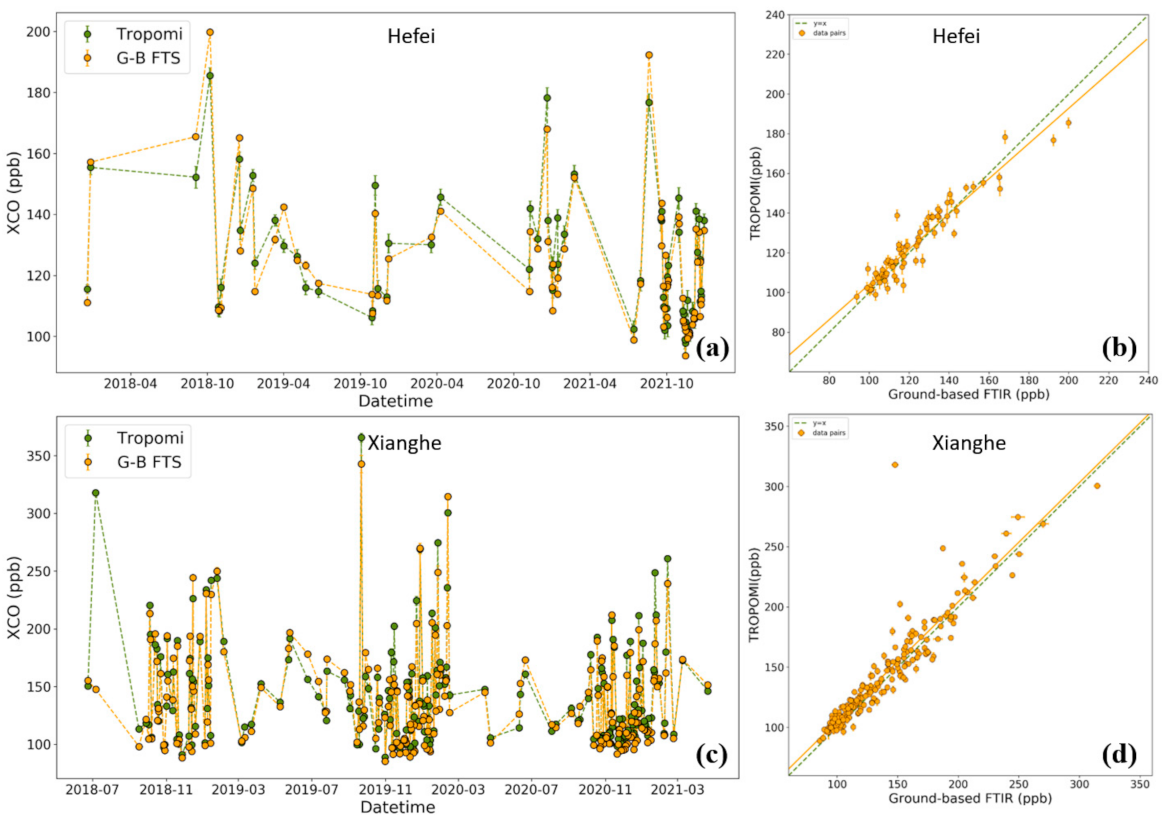
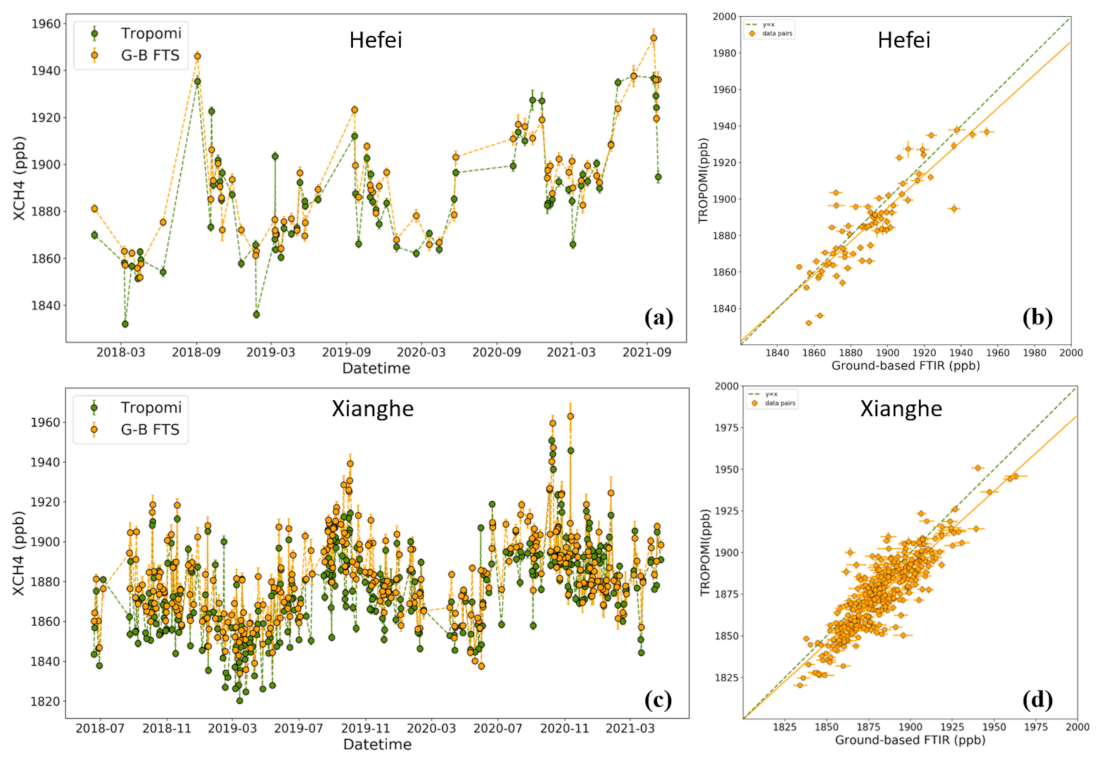
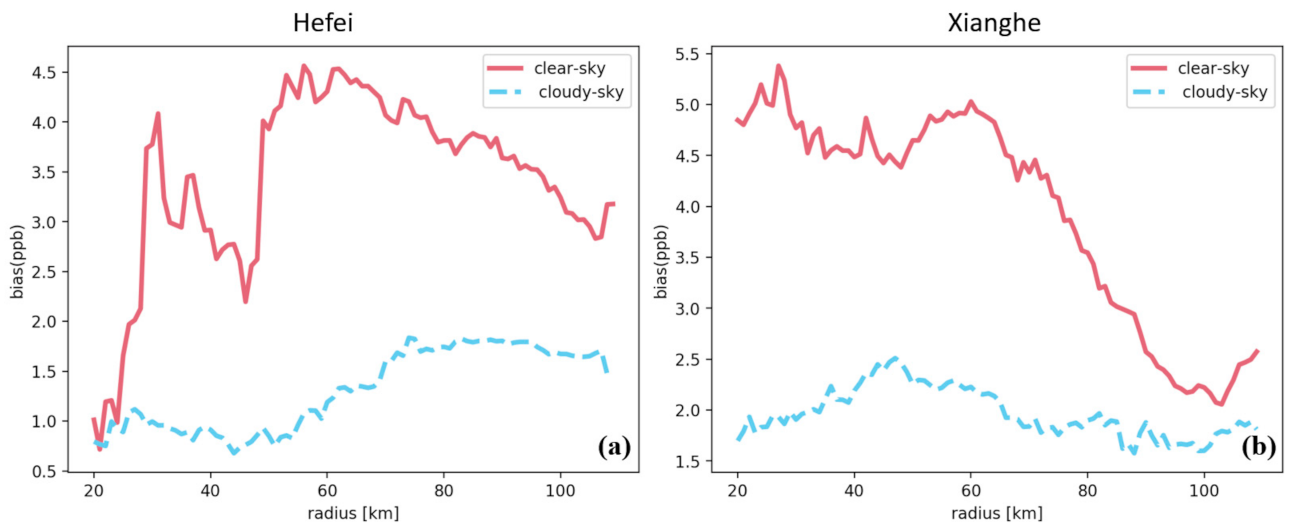
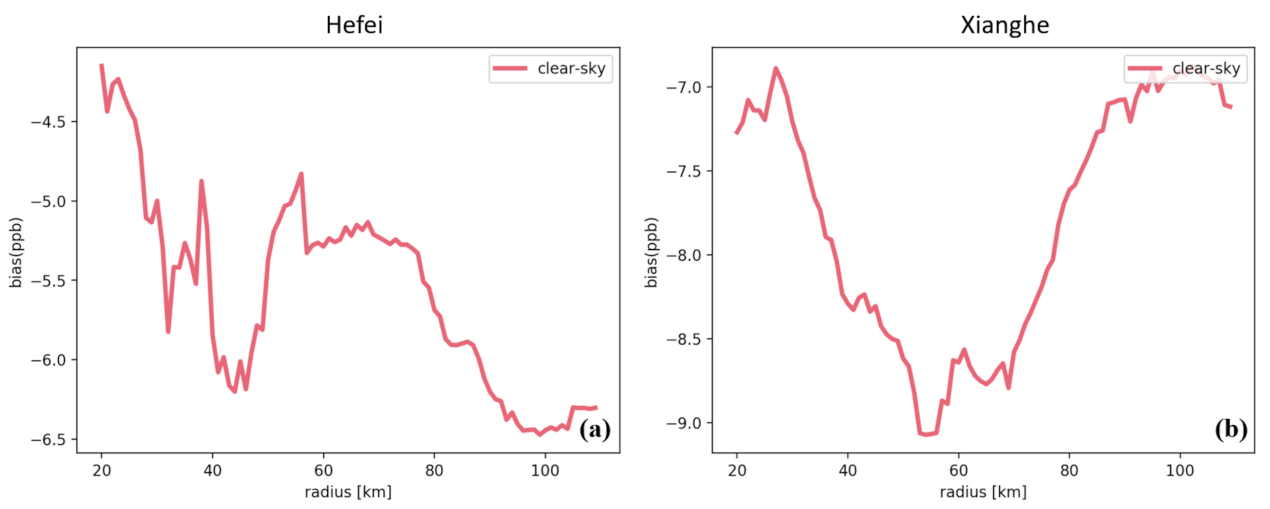
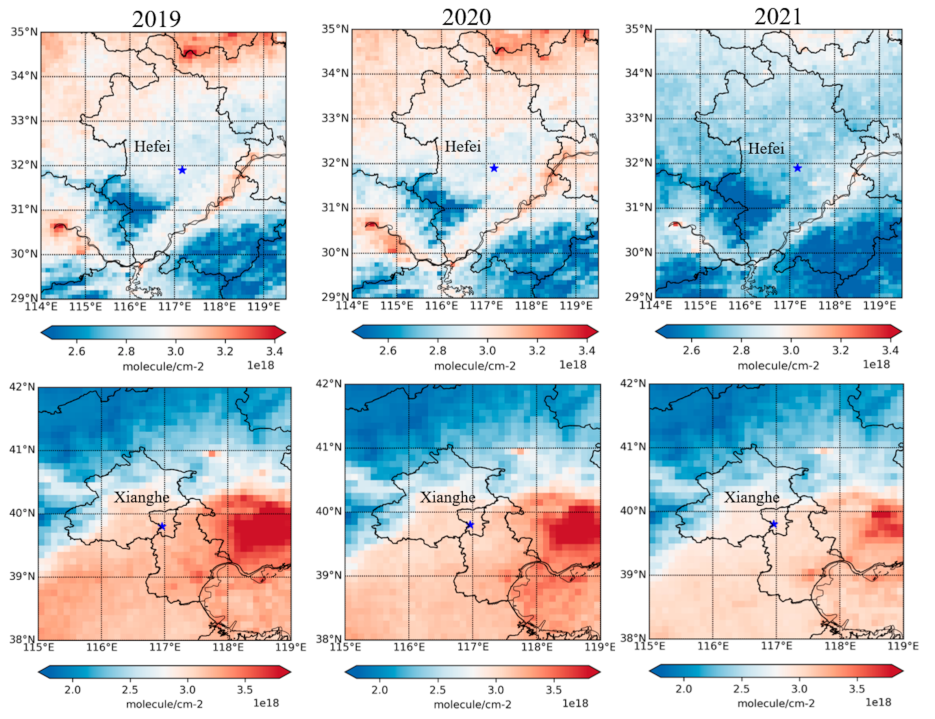
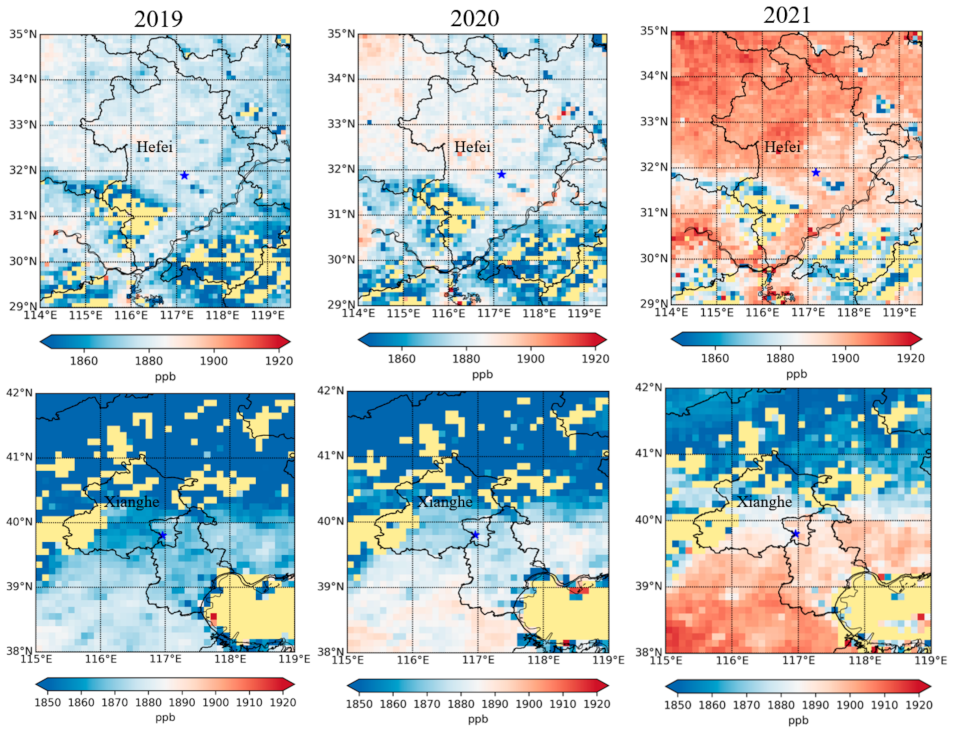
Publisher’s Note: MDPI stays neutral with regard to jurisdictional claims in published maps and institutional affiliations. |
© 2022 by the authors. Licensee MDPI, Basel, Switzerland. This article is an open access article distributed under the terms and conditions of the Creative Commons Attribution (CC BY) license (https://creativecommons.org/licenses/by/4.0/).
Share and Cite
Tian, Y.; Hong, X.; Shan, C.; Sun, Y.; Wang, W.; Zhou, M.; Wang, P.; Lin, P.; Liu, C. Investigating the Performance of Carbon Monoxide and Methane Observations from Sentinel-5 Precursor in China. Remote Sens. 2022, 14, 6045. https://doi.org/10.3390/rs14236045
Tian Y, Hong X, Shan C, Sun Y, Wang W, Zhou M, Wang P, Lin P, Liu C. Investigating the Performance of Carbon Monoxide and Methane Observations from Sentinel-5 Precursor in China. Remote Sensing. 2022; 14(23):6045. https://doi.org/10.3390/rs14236045
Chicago/Turabian StyleTian, Yuan, Xinhua Hong, Changgong Shan, Youwen Sun, Wei Wang, Minqiang Zhou, Pucai Wang, Peize Lin, and Cheng Liu. 2022. "Investigating the Performance of Carbon Monoxide and Methane Observations from Sentinel-5 Precursor in China" Remote Sensing 14, no. 23: 6045. https://doi.org/10.3390/rs14236045
APA StyleTian, Y., Hong, X., Shan, C., Sun, Y., Wang, W., Zhou, M., Wang, P., Lin, P., & Liu, C. (2022). Investigating the Performance of Carbon Monoxide and Methane Observations from Sentinel-5 Precursor in China. Remote Sensing, 14(23), 6045. https://doi.org/10.3390/rs14236045





